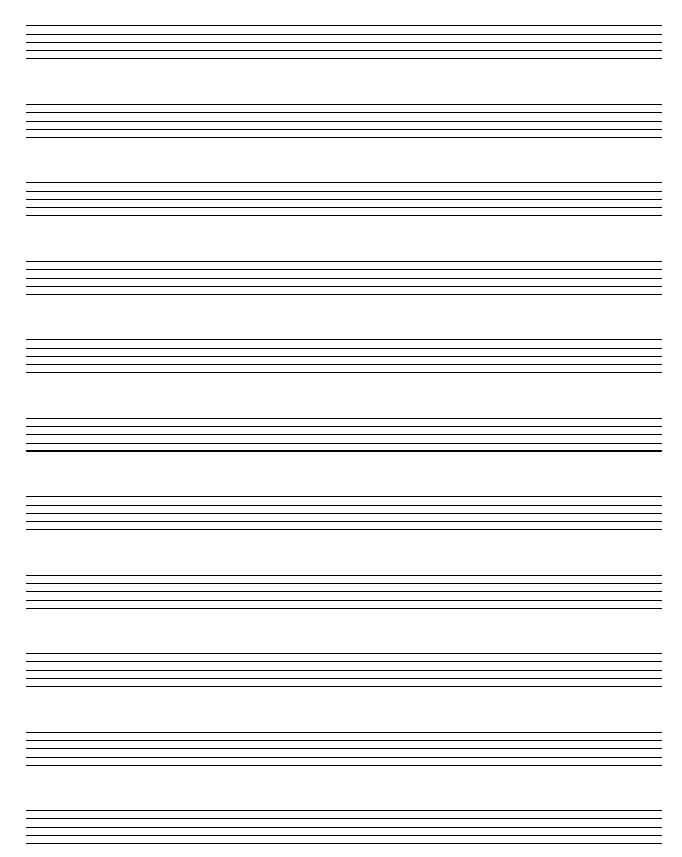MUSIC PAPER 1 GRADE 12 QUESTIONS - NSC PAST PAPERS AND MEMOS FEBRUARY/MARCH 2018
Share via Whatsapp Join our WhatsApp Group Join our Telegram GroupMUSIC
PAPER 1
GRADE 12
NSC PAST PAPERS AND MEMOS
FEBRUARY/MARCH 2018
INSTRUCTIONS AND INFORMATION
- This question paper consists of FIVE sections, namely SECTIONS A, B, C, D and E.
- SECTIONS A and B are COMPULSORY.
- SECTION C: WESTERN ART MUSIC (WAM), SECTION D: JAZZ and SECTION E: INDIGENOUS AFRICAN MUSIC (IAM) are choice questions. Answer only ONE of these sections (SECTION C or D or E).
- Write ALL music notation in SECTION A in pencil and all written text in blue or black ink on this question paper.
- Answer SECTION B and SECTION C or D or E in blue or black ink in the ANSWER BOOK provided.
- Number the answers correctly according to the numbering system used in this question paper.
- The last page of this question paper is manuscript paper intended for rough work. Candidates may remove this page.
- Candidates may NOT have access to any musical instrument for the duration of this examination.
- Candidates must take note of the mark allocation of each question in order to provide enough information in their answer.
- Write neatly and legibly.
Marking Grid
SECTION | QUESTION | MARKS | MARKER | MODERATOR |
A: THEORY OF MUSIC (COMPULSORY) | 1 | 20 | ||
2 | 15 | |||
3 | 10 | |||
4 | 15 | |||
SUBTOTAL | 60 |
|
| |
AND | ||||
B: GENERAL (COMPULSORY) | 5 | 20 | ||
SUBTOTAL | 20 |
|
| |
AND | ||||
C: WAM | 6 | 10 | ||
7 | 5 | |||
8 | 5 | |||
9 | 5 | |||
10 | 15 | |||
SUBTOTAL | 40 |
|
| |
OR | ||||
D: JAZZ | 11 | 10 | ||
12 | 5 | |||
13 | 5 | |||
14 | 5 | |||
15 | 15 | |||
SUBTOTAL | 40 |
|
| |
OR | ||||
E: IAM | 16 | 10 | ||
17 | 5 | |||
18 | 5 | |||
19 | 5 | |||
20 | 15 | |||
SUBTOTAL | 40 |
|
| |
| ||||
GRAND TOTAL | 120 |
|
| |
QUESTIONS
SECTION A: THEORY OF MUSIC (COMPULSORY) (90 minutes)
- Answer QUESTION 1
- AND QUESTION 2.1 OR 2.2
- AND QUESTION 3.1 OR 3.2
- AND QUESTION 4.1 OR 4.2.
Answer the questions in the spaces provided on this question paper.
QUESTION 1 (25 minutes)
Study the extract from Send in the Clowns by Stephen Sondheim below and answer the questions that follow.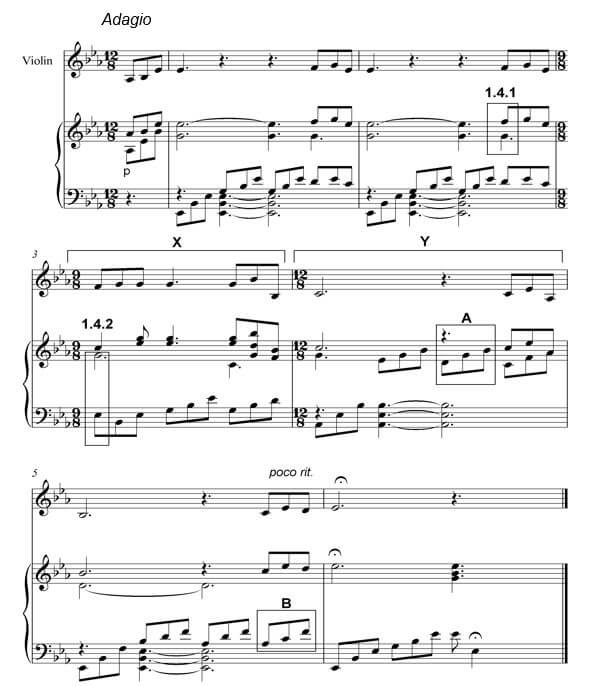
1.1 Name the key of the work.
__________________________________________ (1)
1.2 What is the relative minor of the main key?
__________________________________________ (1)
1.3 Transpose the first four notes of the violin part a major third higher on the given stave below. Use a new key signature.(2)
1.4Name the intervals at 1.4.1 and 1.4.2 according to type and distance.
1.4.1 _____________________________________
1.4.2 _____________________________________ (2)
1.5
Name the triads at A and B according to type and position, for example Major, second inversion. (Consider ONLY the notes in the block.)
A: ______________________________________
B: _______________________________________ (2)
1.6 Rewrite the violin part at X using half the note values. Insert the new time signature.(2)
1.7 Rewrite the violin part at Y in the corresponding simple quadruple time, using the alto clef.(3)
1.8 What is the meaning of the Italian term adagio?
___________________________________________(1)
1.9 In which scale/mode is the melody below written?
_________________________________________________(1)
1.10 Write the melodic form of the B minor scale, descending, using the alto clef. Write without a key signature, use semibreves and mark the semitones.(3)
1.11 Complete the fragment by writing sequences of motif (a) in bars 2 and 3.(2)
[20]
QUESTION 2 (25 minutes)
Answer EITHER QUESTION 2.1 OR QUESTION 2.2.
2.1 Complete the opening motif below to form a twelve-bar melody in ternary form for any single-line melodic instrument of your choice. Name the instrument for which you are writing. Indicate the tempo and add dynamic and articulation marks.
Instrument:______________________________________
The melody will be marked according to the following criteria:
| DESCRIPTION | MARK ALLOCATION | CANDIDATE'S MARKS |
| Form and cadential points | 3 | |
| Correctness Note stems, beats per bar, accidentals, spacing | 2 | |
| Quality Suitability, dynamics, articulation, tempo indication, musicality | 10 | |
| TOTAL | 15 |
[15]
OR
2.2 Complete the opening motif below to form a twelve-bar melody in ternary form for any single-line melodic instrument of your choice. Name the instrument for which you are writing. Indicate the tempo and add dynamic and articulation marks.
Instrument:____________________________________________________
The melody will be marked according to the following criteria:
| DESCRIPTION | MARK ALLOCATION | CANDIDATE'S MARKS |
| Form and cadential points | 3 | |
| Correctness Note stems, beats per bar, accidentals, spacing | 2 | |
| Quality Suitability, dynamics, articulation, tempo indication, musicality | 10 | |
| TOTAL | 15 |
[15]
QUESTION 3 (10 minutes)
Answer EITHER QUESTION 3.1 OR QUESTION 3.2.
3.1 Study the extract below and answer the questions that follow.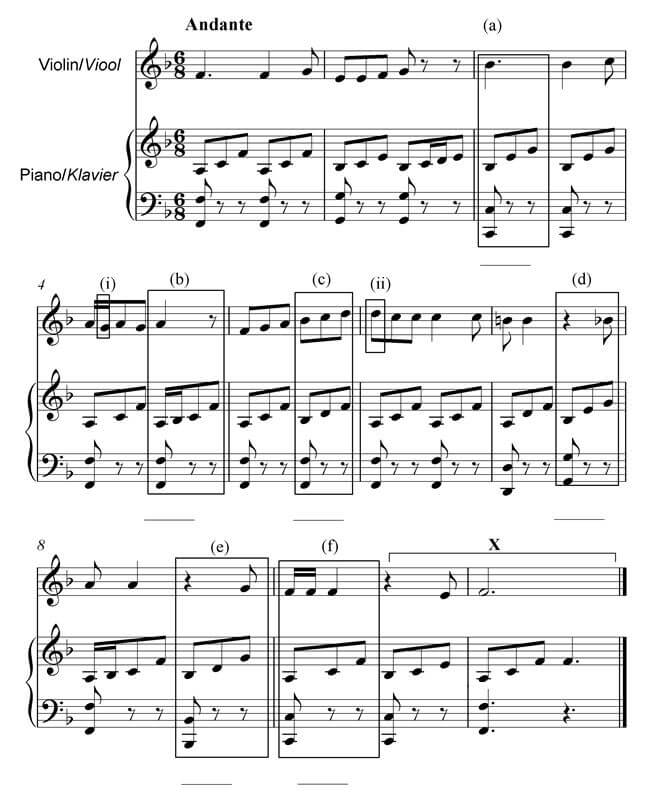
3.1.1 Identify the chords from (a)–(f) and figure them on the score, e.g. iiib/iii6. (6)
3.1.2 Name the type of non-chordal notes at (i) and (ii).
(i) _______________________________________
(ii) _______________________________________(2)
3.1.3 Identify the cadence at X. Write down the chord progression and the name of the cadence.
Chord progression: _______________________________
Cadence: _______________________________(2) [10]
OR
3.2 Study the extract below and answer the questions that follow.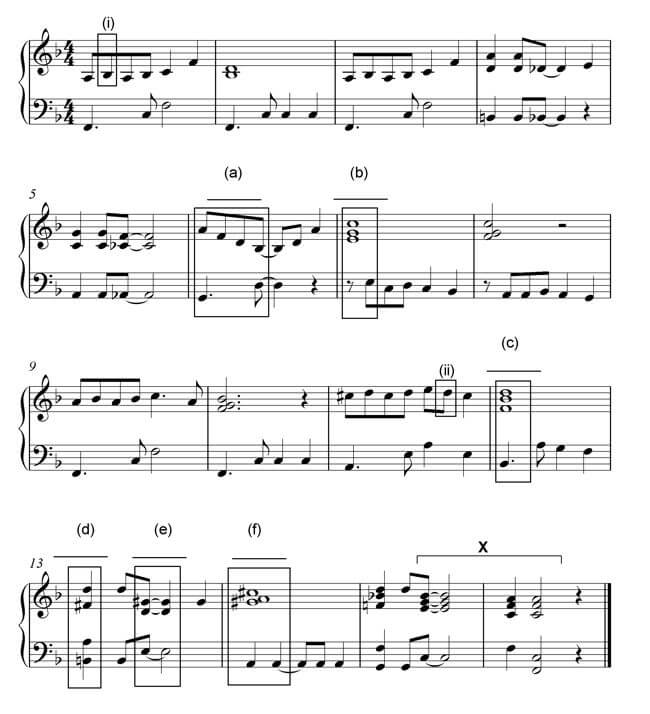
3.2.1 Identify the chords from (a)–(f) and figure them on the score, e.g. B/F#. (6)
3.2.2 Name the type of non-chordal notes at (i) and (ii).
(i)_______________________________________
(ii)_______________________________________(2)
3.2.3 Identify the cadence at X. Write down the chord symbols and the name of the cadence.
Chord symbols: ____________________________________
Cadence: ____________________________________ (2) [10]
QUESTION 4 (30 minutes)
Answer EITHER QUESTION 4.1 OR QUESTION 4.2.
4.1 Complete the four-part vocal harmonisation below by adding the alto, tenor and bass parts.
The harmonisation will be marked according to the following criteria:
| DESCRIPTION | MARK ALLOCATION | CANDIDATE'S MARKS |
| Chord progression Choice of chords, correct use of cadecence | 12 | |
| Correctness Notation, doubling, spacing, voice leading | 14 | |
| Quality Musicality, non-chordal notes, awareness of style, creativity | 4 | |
| 30/2 | ||
| TOTAL | 15 |
[15]
OR
4.2 Complete the piece below by adding suitable harmonic material in the open stave. Continue in the style suggested by the given material in bar 1.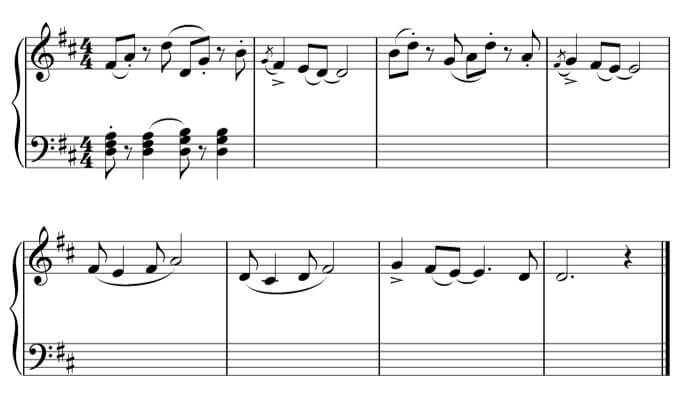
The harmonic material will be marked according to the following criteria:
| DESCRIPTION | MARK ALLOCATION | CANDIDATE'S MARKS |
| Chord progression Choice of chords, correct use of cadecence | 12 | |
| Correctness Notation, doubling, spacing, voice leading | 14 | |
| Quality Musicality, non-chordal notes, awareness of style, creativity | 4 | |
| 30/2 | ||
| TOTAL | 15 |
[15]
TOTAL SECTION A: 60
SECTIONS B, C, D, E: GENERAL MUSIC KNOWLEDGE (90 minutes)
- Answer SECTION B
- AND SECTION C (Western Art Music)
- OR SECTION D (Jazz)
- OR SECTION E (Indigenous African Music).
Answer ALL the questions in the ANSWER BOOK provided.
SECTION B: GENERAL (COMPULSORY)
QUESTION 5
5.1 Various options are provided as possible answers to the following questions. Choose the answer and write only the letter (A–D) next to the question number (5.1.1–5.1.10) in the ANSWER BOOK, for example 5.1.11 D.
5.1.1 How do you register and protect the copyright of your latest composition?
- Register the work at the magistrate's court.
- Post the work to a music publisher.
- Post the work to yourself.
- Ask your teacher to certify your work.
5.1.2 The following term is associated with the music industry:
- Needlework
- Needletime
- Needytime
- Needlepoint
5.1.3 The function of the recording company is to …
- advertise and distribute CDs.
- help artists to get a recording contract.
- record the artist's songs (album).
- All the above-mentioned
5.1.4 The function of a publishing company is to …
- prepare scores for publication.
- register the songs with an agency.
- collect the money and pay the songwriters their royalties.
- All the above-mentioned
5.1.5 Which ONE of the following is NOT involved in the music rights representation of the South African music industry?
- CAPASSO
- SAMRO
- EMI
- SAFACT
5.1.7 The term enharmonic describes notes with the same pitch which have …
- from the 4th to the 7th steps of a major scale.
- associated with dissonance in music.
- also called an augmented 4th interval.
- All the above-mentioned
5.1.6 The term tri-tone is …
- the same note value.
- the same key signature.
- different letternames.
- All the above-mentioned
5.1.8 Timbre is a particular …
- sound quality of an instrument or voice.
- form type in music.
- dynamic change in a piece, e.g. crescendo.
- change of time signature.
5.1.9 A whole-tone scale is a scale consisting of seven …
- semi-tones.
- minor 3rds.
- whole tones.
- None the above-mentioned
5.1.10 The term genre refers to a type of …
- scale.
- form.
- work.
- style. (10 x 1) (10)
5.2 Choose ONE description from COLUMN B that matches a term in COLUMN A. Write only the letter (A–R) next to the question number (5.2.1–5.2.10) in your ANSWERBOOK, for example 5.2.11 S.
| COLUMN A | COLUMN B |
5.2.1 Idiophone |
|
(10 x 1) (10)
TOTAL SECTION B: 20
Answer SECTION C (WAM)
OR SECTION D (JAZZ)
OR SECTION E (IAM).
SECTION C: WESTERN ART MUSIC (WAM)
QUESTION 6
6.1 Describe the form types of the following. Include references to key and key change.
6.1.1 Minuet and trio form (3)
6.1.2 Rondo form (3)
6.2 Define opera. (2)
6.3 What is the difference between Opera Buffa and Opera Seria? (2) [10]
QUESTION 7
Name ONE important aspect of EACH of the following elements with regard to Mendelssohn's Hebrides Overture: form, keys, harmony, dynamics and mood.[5]
QUESTION 8
Define the term aria and describe how the aria, Der Hölle Rache kocht in meinem herzen/The Hellish Fire Boils In My Heart, contributes towards the mood/atmosphere in Mozart's The Magic Flute. [5]
QUESTION 9
9.1 Identify the following motifs taken from works you have studied. Name the work and, where applicable, the movement from which EACH one comes.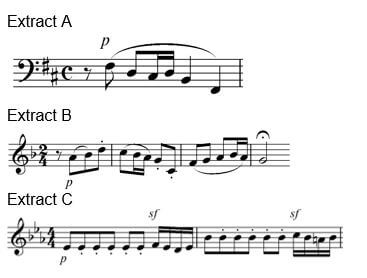 (3)
(3)
9.2 Name the stringed instruments that play the opening motifs in extracts A and B. (2) [5]
QUESTION 10
Write an essay in which you discuss Beethoven's creation of a programmatic symphony and how he achieved this goal through the use of instruments and tone painting in his Symphony No. 6.
The essay will be marked according to the following criteria:
| CRITERIA | MARK ALLOCATION |
| Programmatic content | 6 |
| Instrumentation/Tone Painting | 6 |
| Logical presentation and structure of the essay | 3 |
| TOTAL | 15 |
[15]
TOTAL SECTION C: 40
OR
SECTION D: JAZZ
QUESTION 11
11.1 Briefly describe the melody and rhythm of typical Cape jazz. (2)
11.2 Identify the features which make Spokes Mashiyane, Lemmy 'Special' Mabaso and Elias Lerole's music typical of the kwela style. (4)
11.3 Which South African jazz style do you associate with the following?
11.3.1 Ragtime
11.3.2 Organ sound
11.3.3 Mardi Gras
11.3.4 Avante-garde (4) [10]
QUESTION 12
Write a paragraph on the music contribution of ONE of the following South African female jazz artists:
- Dolly Rathebe
- Thandi Klaasen
- Miriam Makeba [5]
QUESTION 13
Describe the characteristics of the music of the band, The Brotherhood of Breath. [5]
QUESTION 14
Write a paragraph on the style characteristics that you would hear in a mbaqanga song. [5]
QUESTION 15
Write an essay in which you discuss the traditional and international influences on marabi as a South African jazz style. Include ONE artist and ONE song in your answer.
The essay will be marked according to the following criteria:
| CRITERIA | MARK ALLOCATION |
| Traditional influences | 6 |
| International influences | 4 |
| Artist and song | 2 |
| Logical presentation and structure of the essay | 3 |
| TOTAL | 15 |
[15]
TOTAL SECTION D: 40
OR
SECTION E: INDIGENOUS AFRICAN MUSIC (IAM)
QUESTION 16
16.1 Briefly define maskandi music in TWO sentences. (2)
16.2 Which stylistic features of free kiba makes it a traditional style of South African music? (4)
16.3 Which South African indigenous style do you associate with the following terms?
16.3.1 A cappella (1)
16.3.2 Ukupika (1)
16.4 Indicate whether the following statements are TRUE or FALSE. Write only the words 'true' or 'false' next to the question number, for example 16.4.3 True.
16.4.1 Praise poetry is always part of malombo music. (1)
16.4.2 Music is used in every aspect of life in indigenous African societies. (1) [10]
QUESTION 17
Describe the music characteristics of malombo music. [5]
QUESTION 18
Discuss the importance of dance (movement) in indigenous South African music. [5]
QUESTION 19
Write a paragraph on the style characteristics of mbaqanga songs. [5]
QUESTION 20
Isicathamiya reflects the cultural customs of the Zulu culture.
Write an essay in which you discuss the statement above. Link the cultural customs to the musical style characteristics.
The essay will be marked according to the following criteria:
| CRITERIA | MARK ALLOCATION |
| Cultural customs | 6 |
| Musical style characteristics | 6 |
| Logical presentation and structure of the essay | 3 |
| TOTAL | 15 |
[15]
TOTAL SECTION E: 40
GRAND TOTAL: 120
